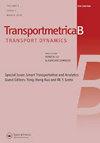一种数据驱动的行人轨迹预测叠加融合方法
IF 3.4
2区 工程技术
Q2 TRANSPORTATION
引用次数: 0
摘要
本文章由计算机程序翻译,如有差异,请以英文原文为准。
A data-driven stacking fusion approach for pedestrian trajectory prediction
This paper systematically investigates pedestrian trajectory prediction through a data-driven stacking fusion approach. Firstly, a novel Attention Mechanism-Long Short-Term Memory Network (Att-LSTM) is presented for pedestrian trajectory prediction, pedestrian heterogeneity and pedestrians–dynamic vehicles interactions are considered. Then, a Modified Social Force Model (MSFM) is developed for pedestrian trajectory prediction. The collision avoidance with conflicting dynamic vehicles and pedestrians, the influence of crosswalk boundary and pedestrian heterogeneity are considered. Finally, a data-driven stacking fusion model based on the Att-LSTM and MSFM is developed, and ridge model is used to prevent model overfitting and enhance model robustness. Moreover, traffic data of an un-signalised crosswalk is collected; the non-measurable parameters are calibrated through the Maximum-Likelihood Estimation. The model evaluation results show that the stacking fusion model performs better than the existing methods, which make it possible for autonomous vehicle to present great feasibility for improving pedestrian safety and traffic efficiency.
求助全文
通过发布文献求助,成功后即可免费获取论文全文。
去求助
来源期刊

Transportmetrica B-Transport Dynamics
TRANSPORTATION SCIENCE & TECHNOLOGY-
CiteScore
5.00
自引率
21.40%
发文量
53
期刊介绍:
Transportmetrica B is an international journal that aims to bring together contributions of advanced research in understanding and practical experience in handling the dynamic aspects of transport systems and behavior, and hence the sub-title is set as “Transport Dynamics”.
Transport dynamics can be considered from various scales and scopes ranging from dynamics in traffic flow, travel behavior (e.g. learning process), logistics, transport policy, to traffic control. Thus, the journal welcomes research papers that address transport dynamics from a broad perspective, ranging from theoretical studies to empirical analysis of transport systems or behavior based on actual data.
The scope of Transportmetrica B includes, but is not limited to, the following: dynamic traffic assignment, dynamic transit assignment, dynamic activity-based modeling, applications of system dynamics in transport planning, logistics planning and optimization, traffic flow analysis, dynamic programming in transport modeling and optimization, traffic control, land-use and transport dynamics, day-to-day learning process (model and behavioral studies), time-series analysis of transport data and demand, traffic emission modeling, time-dependent transport policy analysis, transportation network reliability and vulnerability, simulation of traffic system and travel behavior, longitudinal analysis of traveler behavior, etc.
 求助内容:
求助内容: 应助结果提醒方式:
应助结果提醒方式:


